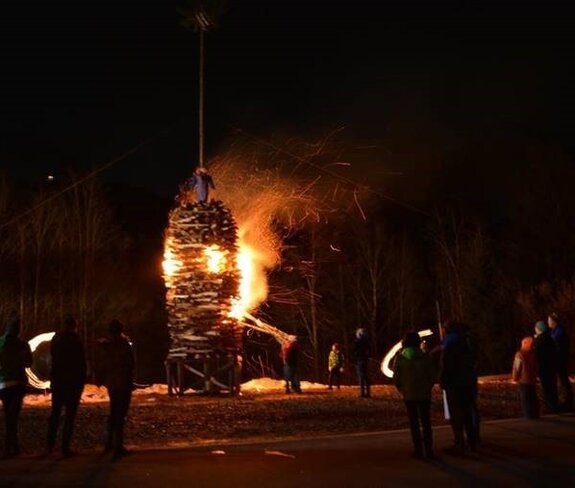
From mystical traditions
The spark fire
Anyone out and about in Vorarlberg on the first weekend after Ash Wednesday will be amazed to see burning wooden towers and impressive fires everywhere. In the Großes Walsertal, you will come across boys parading through the villages with elaborately decorated torches.
What is the story behind this centuries-old ritual?
The traditional burning of sparks is an ancient Swabian-Alemannic tradition whose origins are not fully understood. Some may think that the burning of wooden towers and witch dolls is a remnant of the terrible witch burnings in the early modern era, but this is a misconception! The origins of the fires can be found in ancient pagan fertility rites with sacrificial fires, as well as in the end of the Swabian-Alemannic carnival and the beginning of Lent. In Vorarlberg, the practice of Bonfire Sunday has a long tradition; in almost every municipality, a bonfire is organized by the local spark guild, the local fire department or the carnival guilds. In 2010, Vorarlberg's Spark Sunday was even included in the World Cultural Heritage List.
Every year on Spark Sunday, the so-called spark fir is lit. This is a piled-up wooden tower consisting of collected materials, e.g. old Christmas trees. According to popular belief, the sparks are supposed to drive away winter and ignite happiness. The winter witch, which is attached to the top of the spark, symbolizes the beginning of spring. It is usually prepared with black powder so that it can explode in the fire. Once the spark is lit, the spark master gets nervous... and not without reason! He waits for the witch to explode - if this doesn't happen, she has to be buried the next day.
In Vorarlberg, Spark Sunday has a second name: Chüachlisu(o)nntig - the name says it all! The tasty little cakes, also known as "Polsterzipfel", not only make the hearts of Funkenzunft members beat faster. Eating Fonkachüachli is a must when visiting the Funken - and if you can't get enough, you can easily bake the pastries at home - click here for the recipe.
There are numerous exciting customs surrounding the Funkenfeuer, which are practised differently in each valley - and even in the individual villages. Some Walser customs are still as lively today as they were 100 years ago.
Chrochna knock on the door!
In all villages in the valley (except Thüringerberg), the so-called Chrochna go from house to house between the end of Sunday mass and nightfall. Chrochna are girls of school age and younger boys who knock on the doors of Walser houses and recite their "Chrochnasprüchli". In return they receive a coin, in some houses also Fonkachüachli. In addition to the names "Fonkasu(o)nntig" and "Chüachlisu(o)nntig", this day is therefore also known as "Chrochnasu(o)nntig".
Fachilibuaba as a harbinger of the sparking fire
Fachilibuaba are boys between the ages of 10 and 15 who parade from house to house with elaborate torches made of wood and sometimes decorated with large "cocks" (round shavings) and crepe paper.
Raggal, St. Gerold and Blons
In the municipalities of Raggal, St. Gerold and Blons-Dorf, the Fachilibuaba meet in the late afternoon and parade in groups from house to house. In Blons-Valentschina they meet at midday, but only light their torches in the evening when they meet up with the boys from Blons-Dorf. In these 3 villages, it is customary for the houses in the center to be visited by all the Fachilibuaba together in honor of the occasion.
Sonntag, Buchboden and Fontanella
In Sonntag, Buchboden and Fontanella, the torches lean against the church wall during Sunday mass, as the Fachilibuaba are allowed to set off immediately after the blessing. However, the torches are only lit in the evening when the boys approach the spark. They swing the torches and make their circles until they finally light the spark.
Sources:
Vorarlberg Tourismus, Wikipedia, UNESCO Sparkensonntag, https://cdn3.vol.at/2008/03/Infos_funken.pdf, https://www.grosseswalsertal.at/de/REGIO/Die_Region_Grosses_Walsertal/Geschichte_und_Kultur/Fonkasonntig_oder_Chueachlisonntig, Heimatleuchten: Wild Winter



